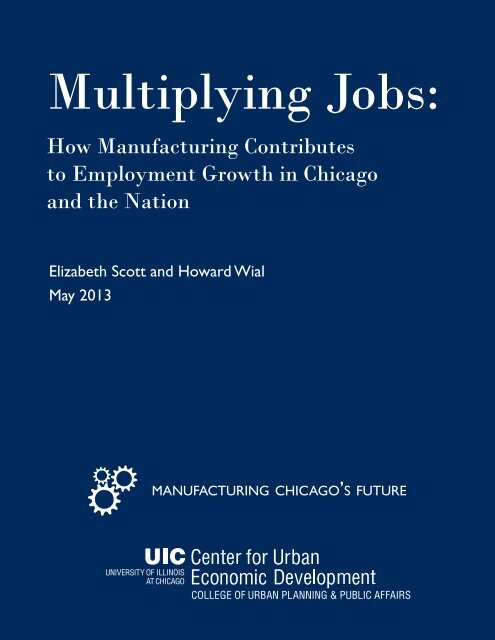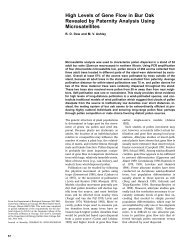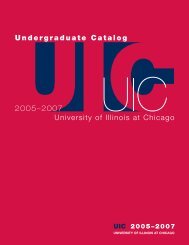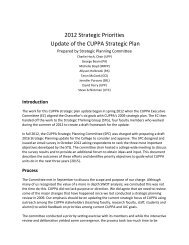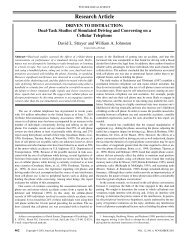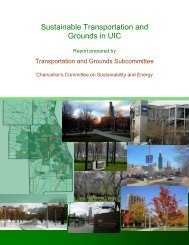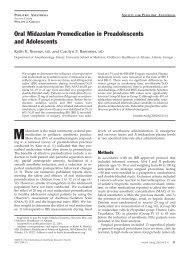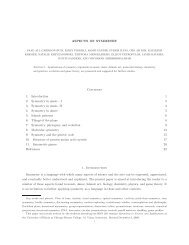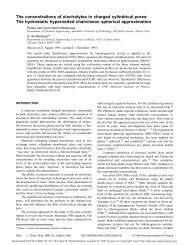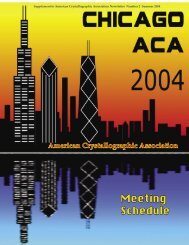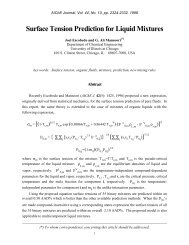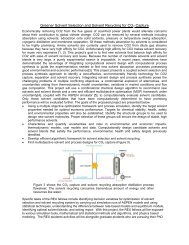Multiplying Jobs: - University of Illinois at Chicago
Multiplying Jobs: - University of Illinois at Chicago
Multiplying Jobs: - University of Illinois at Chicago
Create successful ePaper yourself
Turn your PDF publications into a flip-book with our unique Google optimized e-Paper software.
<strong>Multiplying</strong> <strong>Jobs</strong>:<br />
How Manufacturing Contributes<br />
to Employment Growth in <strong>Chicago</strong><br />
and the N<strong>at</strong>ion<br />
Elizabeth Scott and Howard Wial<br />
May 2013<br />
manufacturing chicago’s future
may 2013<br />
<strong>Multiplying</strong> <strong>Jobs</strong>:<br />
How Manufacturing Contributes<br />
to Employment Growth in <strong>Chicago</strong><br />
and the N<strong>at</strong>ion<br />
Elizabeth Scott and Howard Wial 1<br />
Summary<br />
• In the <strong>Chicago</strong> region, each manufacturing job supports 2.2<br />
additional jobs. Input-output analysis indic<strong>at</strong>es th<strong>at</strong> the manufacturing<br />
employment multiplier for the <strong>Chicago</strong> region is about 3.2. For every<br />
“direct” manufacturing job cre<strong>at</strong>ed in the region, 1.2 “indirect” jobs<br />
are cre<strong>at</strong>ed in supplier companies th<strong>at</strong> provide goods and services for<br />
manufacturing and one additional “induced” job is cre<strong>at</strong>ed to provide<br />
the consumer goods and services th<strong>at</strong> the direct manufacturing employee<br />
purchases. Taken together, these three job impacts cre<strong>at</strong>e a<br />
manufacturing job multiplier <strong>of</strong> 3.2 for the <strong>Chicago</strong> region.<br />
• In the <strong>Chicago</strong> region, each job in petroleum and coal products<br />
manufacturing supports 7.3 additional jobs, while each<br />
job in textile product mills supports 0.5 additional jobs. Manufacturing<br />
industries whose companies buy more goods and services<br />
from suppliers loc<strong>at</strong>ed in the region have larger job multipliers than<br />
those th<strong>at</strong> buy fewer goods and services from within-region suppliers.<br />
High-productivity industries have larger job multipliers than low-productivity<br />
industries.<br />
• N<strong>at</strong>ionwide, each manufacturing job supports up to 4.6 other<br />
jobs. If a small number <strong>of</strong> manufacturing jobs are cre<strong>at</strong>ed throughout<br />
the United St<strong>at</strong>es, then each new manufacturing job is likely to lead<br />
to the cre<strong>at</strong>ion <strong>of</strong> close to 4.6 additional jobs n<strong>at</strong>ionwide. However, if<br />
the n<strong>at</strong>ion gains a large number <strong>of</strong> manufacturing jobs, fewer additional<br />
jobs will be cre<strong>at</strong>ed n<strong>at</strong>ionwide for each manufacturing job added.<br />
Introduction<br />
Economic development policymakers have long prized manufacturing for its jobcre<strong>at</strong>ion<br />
potential. World Business <strong>Chicago</strong>, the city’s nonpr<strong>of</strong>it economic devel-<br />
2<br />
manufacturing chicago’s future
opment organiz<strong>at</strong>ion, identified expanding <strong>Chicago</strong>’s advanced manufacturing sector<br />
as one <strong>of</strong> the pillars <strong>of</strong> its Plan for Economic Growth and <strong>Jobs</strong>. 2 Suburban<br />
economic development organiz<strong>at</strong>ions such as the <strong>Chicago</strong> Southland Economic<br />
Development Corpor<strong>at</strong>ion are also actively pursuing manufacturing job cre<strong>at</strong>ion<br />
as a driver <strong>of</strong> local economic growth and wellbeing. 3<br />
may 2013<br />
Recently, however, concerns about the increasing autom<strong>at</strong>ion <strong>of</strong> manufacturing<br />
plants have led some to question manufacturing’s potential for job cre<strong>at</strong>ion. 4<br />
Yet the importance <strong>of</strong> manufacturing as a gener<strong>at</strong>or <strong>of</strong> jobs depends not only<br />
on how many jobs exist on a manufacturer’s factory floor but also on the other<br />
jobs—in both manufacturing and services—th<strong>at</strong> would not exist in a metropolitan<br />
area such as <strong>Chicago</strong>, or in the entire United St<strong>at</strong>es, if th<strong>at</strong> manufacturer<br />
were not present. This briefing paper, the second in CUED’s Manufacturing <strong>Chicago</strong>’s<br />
Future series, focuses on the ways in which manufacturing jobs are linked to<br />
other jobs and shows the numbers <strong>of</strong> jobs th<strong>at</strong> depend on manufacturing employment<br />
in the <strong>Chicago</strong> region and the n<strong>at</strong>ion as a whole.<br />
Methodology<br />
This briefing paper covers the <strong>Illinois</strong> counties <strong>of</strong> Cook, DuPage, Kane, Kendall,<br />
Lake, McHenry, and Will, which make up the <strong>Chicago</strong> region as defined by the<br />
<strong>Chicago</strong> Metropolitan Agency for Planning. It uses the North American Industry<br />
Classific<strong>at</strong>ion System (NAICS) definition <strong>of</strong> manufacturing, which includes<br />
as manufacturing workers everyone employed in a manufacturing establishment,<br />
production workers, engineers, managers, and maintenance workers alike. It<br />
does not include people who work in free-standing R&D centers, corpor<strong>at</strong>e<br />
headquarters, or other free-standing facilities th<strong>at</strong> are not factories and are not<br />
immedi<strong>at</strong>ely adjacent to factories, even if they work for manufacturing companies.<br />
This briefing paper generally classifies manufacturing industries <strong>at</strong> the NA-<br />
ICS three-digit level. However, it considers some industries (aerospace, medical<br />
devices, motor vehicles and parts, and pharmaceuticals) <strong>at</strong> a more detailed level<br />
because <strong>of</strong> their particular importance to the economy <strong>of</strong> the <strong>Chicago</strong> region or<br />
th<strong>at</strong> <strong>of</strong> the n<strong>at</strong>ion.<br />
The briefing paper uses 2011 IMPLAN d<strong>at</strong>a and input-output modeling s<strong>of</strong>tware<br />
to estim<strong>at</strong>e manufacturing employment multipliers—the total numbers <strong>of</strong> jobs<br />
th<strong>at</strong> are cre<strong>at</strong>ed when a manufacturing job is cre<strong>at</strong>ed. Input-output models<br />
describe the way industries are connected to one another; they are based on the<br />
fact th<strong>at</strong> each industry’s non-labor production inputs are the outputs <strong>of</strong> other<br />
industries. IMPLAN is a standard s<strong>of</strong>tware package th<strong>at</strong> economic development<br />
analysts <strong>of</strong>ten use to project the jobs cre<strong>at</strong>ed in a region when a company<br />
moves to or expands within a region. (See the Technical Appendix for details.)<br />
The briefing paper includes separ<strong>at</strong>e analyses for manufacturing as a whole and<br />
for individual manufacturing industries, and for the <strong>Chicago</strong> region and the entire<br />
United St<strong>at</strong>es.<br />
multiplying jobs<br />
3
may 2013<br />
Box 1. Employment Multipliers<br />
Economists and urban planners <strong>of</strong>ten divide regional economies into two components: industries th<strong>at</strong><br />
export goods or services to other regions—thus bringing income into the region from elsewhere—<br />
and local-serving industries th<strong>at</strong> provide services and a few goods th<strong>at</strong> are sold to the people who<br />
live in the region. Nearly all manufacturing industries are regional export industries because nearly all<br />
the products produced by a factory in a particular region are sold to people who live elsewhere. The<br />
same is true <strong>of</strong> some service industries, such as stock exchanges, corpor<strong>at</strong>e law firms, hotels, and parts<br />
<strong>of</strong> higher educ<strong>at</strong>ion and health care. Supermarkets, dentists’ <strong>of</strong>fices, and dry cleaners are examples <strong>of</strong><br />
local-serving industries.<br />
The idea <strong>of</strong> a multiplier is based on this division <strong>of</strong> the economy into export and local-serving industries.<br />
Employment multipliers measure the interconnectedness <strong>of</strong> different industries in the local<br />
economy, estim<strong>at</strong>ing how many total additional jobs will be cre<strong>at</strong>ed in a region as a result when the<br />
region gains one new job in a particular industry. 5 In general, regional export industries have multipliers<br />
gre<strong>at</strong>er than 1.0.<br />
Multipliers have three components, commonly called direct, indirect and induced effects. The direct effect<br />
<strong>of</strong> the manufacturing employment multiplier is one additional job in manufacturing in a region. The<br />
indirect effect measures how many more jobs will be cre<strong>at</strong>ed in the companies in the same region th<strong>at</strong><br />
supply the goods and services th<strong>at</strong> th<strong>at</strong> manufacturing worker’s employer needs to produce the additional<br />
annual output <strong>of</strong> th<strong>at</strong> worker. The induced effect represents the way th<strong>at</strong> worker spends his or<br />
her wages within the region, cre<strong>at</strong>ing jobs in local-serving industries.<br />
For example, petroleum and coal products manufacuring has an employment multiplier <strong>of</strong> 8.3 in the<br />
<strong>Chicago</strong> region. This multiplier is composed <strong>of</strong> a direct effect <strong>of</strong> 1.0, an indirect effect <strong>of</strong> 4.7, and an<br />
induced effect <strong>of</strong> 2.6. This means th<strong>at</strong> the when one new job in petroleum and coal products is cre<strong>at</strong>ed<br />
in the region, 4.7 jobs are cre<strong>at</strong>ed in industries th<strong>at</strong> produce intermedi<strong>at</strong>e inputs for petroleum<br />
and coal products manufacturing and 2.6 local-serving jobs are cre<strong>at</strong>ed. All <strong>of</strong> these together make up<br />
the multiplier:<br />
1 “direct” petroleum and coal products job<br />
+ 4.7 “indirect” jobs in supplier industries<br />
+ 2.6 “induced” jobs in local-serving industries<br />
= 8.3 employment multiplier<br />
Note th<strong>at</strong> 8.3 includes the one direct job in petroleum and coal products. Thus, it is correct to say<br />
either th<strong>at</strong> one new petroleum and coal products job adds 7.3 other jobs to the local economy or th<strong>at</strong><br />
one new job in coal and petroleum products results in the cre<strong>at</strong>ion <strong>of</strong> a total <strong>of</strong> 8.3 jobs overall. Politicians<br />
and news reporters <strong>of</strong>ten overst<strong>at</strong>e multipliers by confusing these two interpret<strong>at</strong>ions.<br />
4<br />
manufacturing chicago’s future
Findings<br />
A. In the <strong>Chicago</strong> region, each manufacturing job supports 2.2 additional<br />
jobs.<br />
may 2013<br />
The IMPLAN analysis indic<strong>at</strong>es th<strong>at</strong> the manufacturing employment multiplier for<br />
the <strong>Chicago</strong> region is about 3.2. For every direct manufacturing job cre<strong>at</strong>ed in<br />
the region, 1.2 indirect jobs are cre<strong>at</strong>ed in supplier companies th<strong>at</strong> provide goods<br />
and services for manufacturing and one additional induced job is cre<strong>at</strong>ed to provide<br />
the consumer goods and services th<strong>at</strong> the direct manufacturing employee<br />
purchases.<br />
This result is consistent with the most reliable estim<strong>at</strong>es <strong>of</strong> metropolitan manufacturing<br />
multipliers found in the economic development liter<strong>at</strong>ure from the<br />
1950s to the present. The estim<strong>at</strong>es in the liter<strong>at</strong>ure place the employment<br />
multiplier for manufacturing as a whole somewhere between 2.5 and 6, with the<br />
most reliable academic estim<strong>at</strong>es ranging from 2.5 to 3.5. This vari<strong>at</strong>ion is a result<br />
<strong>of</strong> three factors: the timeframe <strong>of</strong> the d<strong>at</strong>a, the geography under analysis, and<br />
the specific analytical tools and assumptions used. However, multiplier estim<strong>at</strong>es<br />
between 2.5 and 3.5 appear in the most reliable studies regardless <strong>of</strong> metropolitan<br />
area, time period, the industry classific<strong>at</strong>ion system used to define manufacturing,<br />
and the type <strong>of</strong> economic model (regional input-output model, econometric<br />
model, or simple r<strong>at</strong>io <strong>of</strong> export to local-serving jobs) used to produce the<br />
estim<strong>at</strong>es. 6<br />
B. In the <strong>Chicago</strong> region, each job in petroleum and coal products<br />
manufacturing supports 7.3 additional jobs, while each job in textile<br />
product mills supports 0.5 additional jobs.<br />
Table 1 shows IMPLAN estim<strong>at</strong>es <strong>of</strong> manufacturing employment multipliers for<br />
individual manufacturing industries in the <strong>Chicago</strong> region. The vari<strong>at</strong>ion in size<br />
between these manufacturing industry employment multipliers is primarily due<br />
to the amount <strong>of</strong> within-region purchasing done by firms in the industry and<br />
the industry’s labor productivity. Industries whose firms buy more goods and<br />
services from suppliers loc<strong>at</strong>ed in the region (e.g., because they have large local<br />
supply chains) gener<strong>at</strong>e more indirect jobs as a result <strong>of</strong> each direct job cre<strong>at</strong>ed<br />
in the industry. Industries with high labor productivity (measured by value added<br />
per job) typically <strong>of</strong>fer high average wages, leading to a large amount <strong>of</strong> withinregion<br />
purchasing by people employed in the industry and, hence, a large number<br />
<strong>of</strong> induced jobs cre<strong>at</strong>ed.<br />
Manufacturing industries with large induced employment effects also tend to<br />
have large indirect employment effects (figure 1). There is an extremely high correl<strong>at</strong>ion<br />
across manufacturing industries (0.86) between number <strong>of</strong> indirect jobs<br />
and the number <strong>of</strong> induced jobs cre<strong>at</strong>ed for each direct job cre<strong>at</strong>ed in the region.<br />
multiplying jobs<br />
5
may 2013<br />
Manufacturing industries with large local supply chains (<strong>of</strong>ten the more capitalintensive<br />
industries) and/or higher value added per job (typically more capitalor<br />
skill-intensive industries) generally have the highest employment multipliers<br />
because they have high indirect and induced job impacts.<br />
Table 1. <strong>Chicago</strong> Region Manufacturing Employment Multipliers, 2011<br />
industry<br />
direct<br />
jobs<br />
indirect<br />
jobs<br />
induced<br />
jobs<br />
employment<br />
multiplier*<br />
All Manufacturing 1.0 1.2 1.0 3.2<br />
Petroleum and Coal Products Manufacturing 1.0 4.7 2.6 8.3<br />
Pharmaceutical Manufacturing 1.0 2.4 2.2 5.7<br />
Chemical Manufacturing (not Pharmaceuticals) 1.0 1.6 1.3 3.8<br />
Beverage and Tobacco Products Manufacturing 1.0 1.6 1.0 3.6<br />
Computer and Electronic Products Manufacturing 1.0 1.0 0.8 2.8<br />
Primary Metal Manufacturing 1.0 1.2 0.5 2.7<br />
Motor Vehicle and Parts Manufacturing 1.0 1.4 0.2 2.6<br />
Food Manufacturing 1.0 0.9 0.7 2.6<br />
Machinery Manufacturing 1.0 0.7 0.8 2.5<br />
Medical Device Manufacturing 1.0 0.5 1.0 2.5<br />
Railroad and Other Transport<strong>at</strong>ion Equipment Manufacturing 1.0 1.1 0.4 2.5<br />
Paper Manufacturing 1.0 0.7 0.7 2.4<br />
Electrical Equipment, Appliance and Component Manufacturing 1.0 0.6 0.7 2.3<br />
Nonmetallic Mineral Products Manufacturing 1.0 0.6 0.6 2.3<br />
Le<strong>at</strong>her and Allied Products Manufacturing 1.0 0.6 0.6 2.2<br />
Miscellaneous Manufacturing 1.0 0.4 0.7 2.1<br />
Fabric<strong>at</strong>ed Metal Products Manufacturing 1.0 0.5 0.5 2.0<br />
Plastics and Rubber Products Manufacturing 1.0 0.4 0.5 2.0<br />
Furniture and Rel<strong>at</strong>ed Products Manufacturing 1.0 0.4 0.5 1.9<br />
Aerospace Products and Parts Manufacturing 1.0 0.6 0.3 1.9<br />
Textile Mills 1.0 0.4 0.4 1.8<br />
Printing and Rel<strong>at</strong>ed Support Activities 1.0 0.3 0.4 1.8<br />
Apparel Manufacturing 1.0 0.3 0.3 1.7<br />
Wood Products Manufacturing 1.0 0.3 0.4 1.7<br />
Textile Product Mills 1.0 0.2 0.3 1.5<br />
* total jobs cre<strong>at</strong>ed when one direct job is cre<strong>at</strong>ed<br />
Source: Authors’ estim<strong>at</strong>es using IMPLAN 3.0 2011 <strong>Illinois</strong> d<strong>at</strong>a for Cook, DuPage, Kane, Kendall, Lake, McHenry, and Will counties.<br />
6<br />
manufacturing chicago’s future
may 2013<br />
Figure 1. Components <strong>of</strong> <strong>Chicago</strong> Region Manufacturing Employment Multipliers<br />
9.0<br />
8.0<br />
7.0<br />
6.0<br />
5.0<br />
4.0<br />
3.0<br />
2.0<br />
1.0<br />
0.0<br />
Petroleum and Coal Products<br />
Pharmaceuticals<br />
Chemicals (not Pharmaceuticals)<br />
Beverage and Tobacco Products<br />
Computer and Electronic Products<br />
Primary Metals<br />
Motor Vehicles and Parts<br />
Food<br />
Machinery<br />
Medical Devices<br />
Railroad and Other Transport<strong>at</strong>ion Equipment<br />
Paper<br />
Electrical Equipment, Appliances and Components<br />
Nonmetallic Mineral Products<br />
Le<strong>at</strong>her and Allied Products<br />
Miscellaneous Manufacturing<br />
Fabric<strong>at</strong>ed Metal Products<br />
Plastics and Rubber Products<br />
Furniture and Rel<strong>at</strong>ed Products<br />
Aerospace Products and Parts<br />
Textile Mills<br />
Printing and Rel<strong>at</strong>ed Support Activities<br />
Apparel<br />
Wood Products<br />
Textile Product Mills<br />
All Manufacturing<br />
Direct Job Direct Job Indirect Indirect <strong>Jobs</strong> <strong>Jobs</strong>Induced Induced <strong>Jobs</strong> <strong>Jobs</strong><br />
Source: Authors’ estim<strong>at</strong>es using IMPLAN 3.0 2011 <strong>Illinois</strong> d<strong>at</strong>a for Cook, DuPage, Kane, Kendall, Lake, McHenry, and Will counties.<br />
multiplying jobs<br />
7
may 2013<br />
C. N<strong>at</strong>ionwide, each manufacturing job supports up to 4.6 other<br />
jobs.<br />
The IMPLAN analysis shows th<strong>at</strong> the n<strong>at</strong>ionwide manufacturing multiplier is 5.6.<br />
Every direct manufacturing job supports 2.4 indirect and 2.2 induced jobs. This<br />
indic<strong>at</strong>es the high degree <strong>of</strong> intensity with which manufacturing firms are interconnected<br />
with one another and the economy as a whole.<br />
There are very few credible estim<strong>at</strong>es <strong>of</strong> n<strong>at</strong>ional employment multipliers for<br />
any industry. One such analysis placed the n<strong>at</strong>ional manufacturing employment<br />
multiplier <strong>at</strong> only 2.9. 7 However, this estim<strong>at</strong>e is based on inferences from and<br />
assumptions about labor market d<strong>at</strong>a, r<strong>at</strong>her than on n<strong>at</strong>ional input-output tables<br />
(the preferred source, on which the IMPLAN analyses are based).<br />
N<strong>at</strong>ional employment multipliers vary among manufacturing industries in much<br />
the same way as multipliers for the <strong>Chicago</strong> region do. They range from a high <strong>of</strong><br />
31.1 in petroleum and coal products to a low <strong>of</strong> 2.6 in printing (table 2).<br />
The n<strong>at</strong>ional manufacturing employment multiplier is much larger than the<br />
<strong>Chicago</strong> (or any other metropolitan) multiplier because the n<strong>at</strong>ion as a whole<br />
contains more <strong>of</strong> the supply chain and encompasses more <strong>of</strong> the induced spending<br />
for any given manufacturing job than does the <strong>Chicago</strong> region (or any other<br />
metropolitan area). For example, a manufacturing job in the <strong>Chicago</strong> region (or<br />
anywhere else in the n<strong>at</strong>ion) is linked to supply chain jobs loc<strong>at</strong>ed throughout the<br />
n<strong>at</strong>ion, not just in the region, so the indirect job impact is gre<strong>at</strong>er for the n<strong>at</strong>ion<br />
than for the region. Similarly, the worker employed in th<strong>at</strong> job spends his or her<br />
earnings throughout the n<strong>at</strong>ion, not just in the region, so the induced job impact<br />
is also gre<strong>at</strong>er for the n<strong>at</strong>ion than for the region.<br />
The n<strong>at</strong>ional manufacturing employment multiplier <strong>of</strong> 5.6 does not mean th<strong>at</strong><br />
adding one million more manufacturing jobs to the n<strong>at</strong>ion as a whole will lead to<br />
the cre<strong>at</strong>ion <strong>of</strong> 4.6 million other jobs in the n<strong>at</strong>ion as a whole. This is because<br />
input-output is a demand-side model th<strong>at</strong> does not consider supply constraints,<br />
including labor supply. 8 For a metropolitan area or other small geographic area,<br />
multipliers can be interpreted in cause-and-effect terms (adding a manufacturing<br />
job causes total employment to increase by more than one job) because it<br />
is rel<strong>at</strong>ively easy for a region to add jobs by drawing in additional workers from<br />
other regions when within-region product demand increases.<br />
This is much more difficult for the n<strong>at</strong>ion as a whole. When one industry (such<br />
as manufacturing) expands, some new immigrants may come to the United<br />
St<strong>at</strong>es to work and some unemployed workers or people who were not previously<br />
looking for jobs may obtain jobs. However, it is much more difficult for the<br />
United St<strong>at</strong>es as a whole to meet the increased demand for workers from an expanding<br />
industry than it is for a metropolitan area to meet the increase in labor<br />
8<br />
manufacturing chicago’s future
demand from a proportionally equal expansion <strong>of</strong> production in th<strong>at</strong> industry. 9<br />
Overall, the impact <strong>of</strong> constraints on the supply <strong>of</strong> available workers <strong>at</strong> the n<strong>at</strong>ional<br />
level is likely to m<strong>at</strong>ter more for large expansions <strong>of</strong> manufacturing than<br />
for small ones. If a small number <strong>of</strong> new manufacturing jobs are cre<strong>at</strong>ed throughout<br />
the United St<strong>at</strong>es, then it will be rel<strong>at</strong>ively easy for companies to fill the new<br />
may 2013<br />
Table 2. United St<strong>at</strong>es Manufacturing Employment Multipliers, 2011<br />
industry<br />
direct<br />
jobs<br />
indirect<br />
jobs<br />
induced<br />
jobs<br />
employment<br />
multiplier*<br />
All Manufacturing 1.0 2.4 2.2 5.6<br />
Petroleum and Coal Products Manufacturing 1.0 16.9 13.2 31.1<br />
Pharmaceutical Manufacturing 1.0 5.7 4.9 11.6<br />
Chemical Manufacturing (not Pharmaceuticals) 1.0 3.6 4.3 9.0<br />
Beverage and Tobacco Manufacturing 1.0 4.1 3.1 8.2<br />
Computer and Electronic Products Manufacturing 1.0 4.0 2.2 7.2<br />
Primary Metal Manufacturing 1.0 3.2 2.6 6.9<br />
Motor Vehicle and Parts Manufacturing 1.0 3.2 2.6 6.8<br />
Food Manufacturing 1.0 2.7 2.4 6.1<br />
Machinery Manufacturing 1.0 2.4 2.6 6.1<br />
Medical Device Manufacturing 1.0 2.4 2.6 5.9<br />
Railroad and Other Transport<strong>at</strong>ion Equipment Manufacturing 1.0 2.4 2.3 5.8<br />
Paper Manufacturing 1.0 1.8 1.6 4.4<br />
Electrical Equipment, Appliance and Component Manufacturing 1.0 1.5 1.8 4.3<br />
Nonmetallic Mineral Products Manufacturing 1.0 1.3 1.4 3.7<br />
Le<strong>at</strong>her and Allied Products Manufacturing 1.0 1.1 1.3 3.4<br />
Miscellaneous Manufacturing 1.0 1.2 1.2 3.4<br />
Fabric<strong>at</strong>ed Metal Products Manufacturing 1.0 1.1 1.3 3.4<br />
Plastics and Rubber Products Manufacturing 1.0 0.8 1.5 3.3<br />
Furniture and Rel<strong>at</strong>ed Products Manufacturing 1.0 1.2 1.0 3.2<br />
Aerospace Products and Parts Manufacturing 1.0 0.9 0.9 2.8<br />
Textile Mills 1.0 0.7 1.1 2.8<br />
Printing and Rel<strong>at</strong>ed Support Activities 1.0 0.8 1.0 2.8<br />
Apparel Manufacturing 1.0 0.8 0.9 2.7<br />
Wood Products Manufacturing 1.0 0.7 0.9 2.6<br />
Textile Product Mills 1.0 0.7 0.7 2.4<br />
* total jobs cre<strong>at</strong>ed when one direct job is cre<strong>at</strong>ed<br />
Source: Authors’ estim<strong>at</strong>es using IMPLAN 3.0 2011 n<strong>at</strong>ional d<strong>at</strong>a.<br />
multiplying jobs<br />
9
may 2013<br />
jobs with unemployed workers, people who previously were not looking for<br />
jobs, or new immigrants, and each new manufacturing job is likely to lead to the<br />
cre<strong>at</strong>ion <strong>of</strong> close to 4.6 additional jobs n<strong>at</strong>ionwide. However, if the n<strong>at</strong>ion gains<br />
a large number <strong>of</strong> manufacturing jobs, then most <strong>of</strong> the jobs linked to each new<br />
manufacturing job, whether direct, indirect, or induced, will be filled by people<br />
already employed in other industries in the United St<strong>at</strong>es. In th<strong>at</strong> case, fewer additional<br />
jobs will be cre<strong>at</strong>ed n<strong>at</strong>ionwide for each manufacturing job added. If the<br />
n<strong>at</strong>ional economy is oper<strong>at</strong>ing <strong>at</strong> full employment and there is no new immigr<strong>at</strong>ion<br />
in response to the expansion <strong>of</strong> manufacturing, then no additional jobs will<br />
be cre<strong>at</strong>ed.<br />
Conclusion<br />
Manufacturing remains a powerful engine <strong>of</strong> job growth through its indirect and<br />
induced job impacts as well as through its direct impacts. Manufacturing’s contribution<br />
to job cre<strong>at</strong>ion would grow if any <strong>of</strong> the three types <strong>of</strong> impacts were<br />
increased. This could occur if U.S. manufacturing employment increased. It could<br />
also occur if more supplier activity (in services as well as in goods) remained<br />
in the United St<strong>at</strong>es or if some consumer spending on imports were replaced<br />
with spending on domestically produced goods and services. Within the <strong>Chicago</strong><br />
region, it could also occur if within-region supply chains were strengthened.<br />
Until recently, the n<strong>at</strong>ionwide growth <strong>of</strong> <strong>of</strong>fshoring and <strong>of</strong> consumer spending on<br />
imported goods and the growing use <strong>of</strong> out-<strong>of</strong>-region suppliers by <strong>Chicago</strong>-area<br />
manufacturers worked to reduce manufacturing’s impact on job cre<strong>at</strong>ion. 10 The<br />
recent rebound <strong>of</strong> manufacturing employment n<strong>at</strong>ionwide and in the <strong>Chicago</strong><br />
region, which is based on long-term economic trends as well as on the recovery<br />
<strong>of</strong> product demand after the Gre<strong>at</strong> Recession, may change this situ<strong>at</strong>ion. 11<br />
10<br />
manufacturing chicago’s future
Technical Appendix<br />
To estim<strong>at</strong>e manufacturing multipliers, we used 2011 d<strong>at</strong>a for IMPLAN Pro 3.0<br />
input-output modeling s<strong>of</strong>tware. (2011 d<strong>at</strong>a are the most recent d<strong>at</strong>a currently<br />
available in IMPLAN. Input-output rel<strong>at</strong>ionships are not likely to change rapidly<br />
in the course <strong>of</strong> one year, so 2012 d<strong>at</strong>a, if they were available, would not produce<br />
results th<strong>at</strong> differ gre<strong>at</strong>ly from those reported here.)<br />
may 2013<br />
IMPLAN has two distinct modes <strong>of</strong> oper<strong>at</strong>ion, one descriptive and the other<br />
predictive. Most analysts use IMPLAN to predict the likely changes to a regional<br />
economy based on some change in final demand, e.g., the construction<br />
and staffing <strong>of</strong> a new airplane factory. In this case, however, we used IMPLAN’s<br />
descriptive mode to deliver the best possible estim<strong>at</strong>es <strong>of</strong> current manufacturing<br />
employment multipliers by industry in both the <strong>Chicago</strong> region and the n<strong>at</strong>ion as<br />
a whole.<br />
The IMPLAN model is built through multipliers th<strong>at</strong> are estim<strong>at</strong>ed based on an<br />
analyst’s specified study area. In this case, Cook, DuPage, Kane, Kendall, Lake,<br />
McHenry, and Will counties were analyzed to m<strong>at</strong>ch the <strong>Chicago</strong> Metropolitan<br />
Agency for Planning’s seven-county <strong>Chicago</strong> region. Within this geography,<br />
IMPLAN estim<strong>at</strong>es all <strong>of</strong> the backward linkages between local industry sectors<br />
<strong>at</strong>, for the most part, the six-digit NAICS level by applying modified n<strong>at</strong>ional<br />
input-output tables to region-specific d<strong>at</strong>a such as employment and value added.<br />
It further adjusts the model with econometrically derived regional purchasing<br />
coefficients. Once all these rel<strong>at</strong>ionships are calcul<strong>at</strong>ed, IMPLAN can describe<br />
multipliers for a number <strong>of</strong> fixed rel<strong>at</strong>ionships within the regional model, including<br />
employment and output.<br />
These estim<strong>at</strong>es made through IMPLAN are the best possible using this model.<br />
However there are a few important elements to take into account th<strong>at</strong> may<br />
infl<strong>at</strong>e or defl<strong>at</strong>e CUED’s final results.<br />
Aggreg<strong>at</strong>ion Bias. IMPLAN provides d<strong>at</strong>a on trade flows and other aspects <strong>of</strong> the<br />
local economy <strong>at</strong> a very fine-grained level <strong>of</strong> detail. To aggreg<strong>at</strong>e these d<strong>at</strong>a sufficiently<br />
to describe multipliers for manufacturing in general, or NAICS three- or<br />
four-digit manufacturing industries, it is necessary to make certain changes to the<br />
model th<strong>at</strong> introduce potentially serious aggreg<strong>at</strong>ion bias. Aggreg<strong>at</strong>ing several<br />
detailed industries (e.g., eyeglass, hearing aid, and prosthetic manufacturing into<br />
medical device manufacturing) effectively cre<strong>at</strong>es a new industry composed out<br />
<strong>of</strong> the industry details <strong>of</strong> the aggreg<strong>at</strong>ed industries. The production function <strong>of</strong><br />
the new aggreg<strong>at</strong>ed industry becomes the output-weighted average <strong>of</strong> the individual<br />
production functions. For this reason, the component industries with<br />
the gre<strong>at</strong>est output levels have the gre<strong>at</strong>est influence on the aggreg<strong>at</strong>ed industry.<br />
Therefore, the aggreg<strong>at</strong>ed industries may not completely represent the underlying<br />
industries but may infl<strong>at</strong>e or defl<strong>at</strong>e the multipliers depending on the constituent<br />
industries.<br />
multiplying jobs<br />
11
may 2013<br />
Geographic coverage. This analysis covers the seven-county <strong>Chicago</strong> region as defined<br />
above, not the <strong>Chicago</strong>-Naperville-Joliet IL-IN-WI Metropolitan St<strong>at</strong>istical<br />
Area. There are a number <strong>of</strong> counties outside the seven-county region, particularly<br />
those in northwest Indiana, th<strong>at</strong> contribute substantially to the metroplitan<br />
area’s manufacturing economy. Metropolitan-level employment multipliers for<br />
industries concentr<strong>at</strong>ed in those omitted counties, such as primary metal manufacturing,<br />
may be larger than the multipliers reported in this briefing paper.<br />
Trade Flows. It was necessary to use two trade flow models in IMPLAN to report<br />
results <strong>at</strong> both local and n<strong>at</strong>ional geographies. For the counties in the <strong>Chicago</strong><br />
region, econometric regional purchasing coefficients (RPCs) were used. These<br />
econometric RPCs set the level <strong>of</strong> the regional propensity to consume locally<br />
(i.e., the extent to which local businesses buy inputs from one another when<br />
those inputs are available for purchase in the region). As the region gets larger,<br />
more customers and suppliers will be available in the network, so the multiplier<br />
will get bigger. At the extreme, the n<strong>at</strong>ional trade flow model is built through<br />
supply-demand pooling, which assumes th<strong>at</strong> everything th<strong>at</strong> can be purchased in<br />
the country will be purchased in the country. In IMPLAN, these estim<strong>at</strong>es represent<br />
an upper bound for all possible multipliers. For this reason, the n<strong>at</strong>ional estim<strong>at</strong>es<br />
are necessarily larger and should not be taken as a sign th<strong>at</strong> the <strong>Chicago</strong><br />
region is substantially less prosperous or competitive than the n<strong>at</strong>ion as a whole.<br />
Other Issues. IMPLAN relies mainly on modified n<strong>at</strong>ional-level d<strong>at</strong>a. More specialized<br />
local inform<strong>at</strong>ion, such as concrete details about regional industries’ wages,<br />
outputs, and supply chains might allow for different multipliers. These d<strong>at</strong>a are,<br />
however, difficult and costly to obtain.<br />
All input-output models also assume fixed-proportions production functions.<br />
Th<strong>at</strong> is the amount <strong>of</strong> each input th<strong>at</strong> is needed to make a unit <strong>of</strong> output remains<br />
constant, as in a recipe. This assumption implies constant returns to scale. (Doubling<br />
all inputs results in a doubling <strong>of</strong> output; there are no benefits or costs to<br />
high levels <strong>of</strong> production or to geographic agglomer<strong>at</strong>ion.)<br />
IMPLAN cannot explicitly model the social or environmental impacts <strong>of</strong> economic<br />
activities. Therefore, it is important for policymakers to keep the quality and<br />
composition <strong>of</strong> impacts in mind as well as their magnitude.<br />
12<br />
manufacturing chicago’s future
Endnotes<br />
1. Elizabeth Scott is an economic<br />
development planner in the Center<br />
for Urban Economic Development <strong>at</strong><br />
The <strong>University</strong> <strong>of</strong> <strong>Illinois</strong> <strong>at</strong> <strong>Chicago</strong>.<br />
Howard Wial is Executive Director<br />
and Associ<strong>at</strong>e Research Pr<strong>of</strong>essor in<br />
the Center for Urban Economic Development<br />
<strong>at</strong> The <strong>University</strong> <strong>of</strong> <strong>Illinois</strong><br />
<strong>at</strong> <strong>Chicago</strong> and Nonresident Senior<br />
Fellow <strong>of</strong> the Brookings Institution<br />
Metropolitan Policy Program.<br />
2. World Business <strong>Chicago</strong>, A Plan for<br />
Economic Growth and <strong>Jobs</strong> (<strong>Chicago</strong>,<br />
2012).<br />
3. See, e.g., Center for Neighborhood<br />
Technology and South Suburban<br />
Mayors and Managers Associ<strong>at</strong>ion,<br />
“<strong>Chicago</strong> Southland’s Green TIME<br />
Zone” (<strong>Chicago</strong>, 2010).<br />
4. See, e.g., Adam Davidson, “Making<br />
It in America,” The Atlantic, January/<br />
February 2012, available <strong>at</strong> http://<br />
www.the<strong>at</strong>lantic.com/magazine/<br />
archive/2012/01/making-it-in-america/308844/.<br />
5. Multipliers are estim<strong>at</strong>ed for many<br />
economic rel<strong>at</strong>ionships, including<br />
output and wages. This briefing paper<br />
focuses solely on employment multipliers.<br />
6. Enrico Moretti, “Local Multipliers,”<br />
American Economic Review 100(2) (May<br />
2010): 373-77; N. Edward Coulson,<br />
“Measuring and Analyzing Urban<br />
Employment Fluctu<strong>at</strong>ions,” in Richard<br />
J. Arnott and Daniel P. McMillen,<br />
eds., A Companion to Urban Economics<br />
(Malden, MA: Blackwell, 2006); Gerald<br />
A Carlino, Robert H. DeFina, and Keith<br />
Sill, “Sectoral Shocks and Metropolitan<br />
Employment Growth,” Journal <strong>of</strong><br />
Urban Economics 50(3) (2001): 396-417;<br />
Sheng-Wen Chang, and , N. Edward<br />
Coulson, “Sources <strong>of</strong> Sectoral Employment<br />
Fluctu<strong>at</strong>ions in Central Cities<br />
and Suburbs: Evidence from Four<br />
Eastern U.S. Cities,” Journal <strong>of</strong> Urban<br />
Economics 49(2) (2001): 199-218; N.<br />
Edward Coulson, “Sectoral Sources<br />
<strong>of</strong> Metropolitan Growth,” Regional<br />
Science and Urban Economics 29(6)<br />
(1999):723-743; Scott J. Brown, N.<br />
Edward Coulson, and Robert F. Engle,<br />
“On the Determin<strong>at</strong>ion <strong>of</strong> Regional<br />
Base and Regional Base Multipliers,”<br />
Regional Science and Urban Economics<br />
22(4) (1992): 619-635.<br />
7. Joshua Bivens, “Upd<strong>at</strong>ed Employment<br />
Multipliers for the U.S. Economy,” Economic<br />
Policy Institute Working Paper<br />
#268 (Washington: Economic Policy<br />
Institute, 2003).<br />
8. In economic terms, an input-output<br />
model does not account for the impacts<br />
<strong>of</strong> price changes th<strong>at</strong> may occur<br />
as a result <strong>of</strong> changes in the demand<br />
for inputs, including labor.<br />
9. Of course, as in metropolitan areas,<br />
the expansion <strong>of</strong> demand for workers<br />
in a given industry can also be met by<br />
drawing into the industry unemployed<br />
workers or people not previously<br />
looking for jobs.<br />
10. On the growth <strong>of</strong> out-<strong>of</strong>-region<br />
purchasing <strong>of</strong> intermedi<strong>at</strong>e inputs by<br />
<strong>Chicago</strong>-area manufacturers, see Ge<strong>of</strong>frey<br />
J.D. Hewings and Michael Sonis,<br />
“The Hollowing Out Process in the<br />
<strong>Chicago</strong> Economy, 1975-2015,” Geographical<br />
Analysis 30 (1998): 217-233.<br />
11. See Susan Helper, Timothy Krueger<br />
and Howard Wial, “Why Does Manufacturing<br />
M<strong>at</strong>ter? Which Manufacturing<br />
M<strong>at</strong>ters?” (Washington: Brookings<br />
Institution, 2012), and Howard Wial,<br />
“Loc<strong>at</strong>ing <strong>Chicago</strong> Manufacturing: The<br />
geography <strong>of</strong> Production in Metropolitan<br />
<strong>Chicago</strong>” (<strong>Chicago</strong>: Center for<br />
Urban Economic Development, The<br />
<strong>University</strong> <strong>of</strong> <strong>Illinois</strong> <strong>at</strong> <strong>Chicago</strong>, 2013).<br />
12. Minnesota IMPLAN Group, IMPLAN<br />
PRO Manual 2.0 (Stillw<strong>at</strong>er, MN, 2004).<br />
may 2013<br />
multiplying jobs<br />
13
Acknowledgments<br />
may 2013<br />
The authors thank Manufacturing Renaissance for its support <strong>of</strong> this research.<br />
The authors are also gr<strong>at</strong>eful to Joshua Drucker and Zafer Sönmez for comments<br />
on the modeling approach used in this research, and to Claire Thomison for<br />
graphic design assistance.<br />
For More Inform<strong>at</strong>ion<br />
Howard Wial<br />
Executive Director and Associ<strong>at</strong>e Research Pr<strong>of</strong>essor<br />
Center for Urban Economic Development<br />
The <strong>University</strong> <strong>of</strong> <strong>Illinois</strong> <strong>at</strong> <strong>Chicago</strong><br />
hwial@uic.edu<br />
312-996-7194<br />
About the Manufacturing <strong>Chicago</strong>’s Future<br />
Series<br />
The <strong>Chicago</strong> metropolitan area is home to some <strong>of</strong> the n<strong>at</strong>ion’s most ambitious<br />
local public-priv<strong>at</strong>e initi<strong>at</strong>ives to strengthen manufacturing. In this series<br />
<strong>of</strong> briefing papers on <strong>Chicago</strong>-area manufacturing, CUED provides economic<br />
development policymakers and practitioners with the inform<strong>at</strong>ion they need<br />
to make these efforts successful.<br />
In the series:<br />
Loc<strong>at</strong>ing <strong>Chicago</strong> Manufacturing: The Geography <strong>of</strong> Production in<br />
Metropolitan <strong>Chicago</strong><br />
About the Center for Urban<br />
Economic Development<br />
The Center for Urban Economic Development (CUED) conducts research,<br />
policy analysis, and evalu<strong>at</strong>ion on urban and regional economic and workforce<br />
development issues. Established in 1978, CUED is a unit <strong>of</strong> the College <strong>of</strong><br />
Urban Planning and Public Affairs <strong>at</strong> the <strong>University</strong> <strong>of</strong> <strong>Illinois</strong> <strong>at</strong> <strong>Chicago</strong> and is<br />
affili<strong>at</strong>ed with the university’s Gre<strong>at</strong> Cities Institute.<br />
See www.urbaneconomy.org.<br />
14<br />
manufacturing chicago’s future


